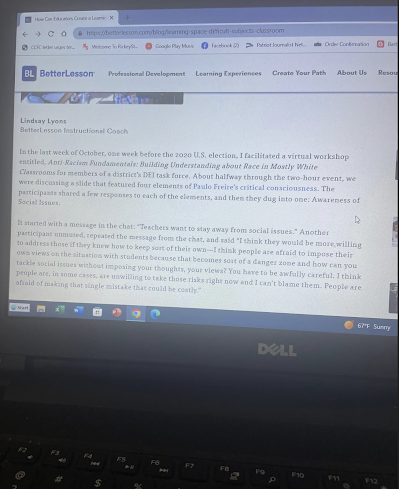In 1923, Lenin recognized the Socialist Movement would not spread to industrialized nations so he brought together a group of scholars to retool their strategy. To camouflage its nature they called it the Institute of Social Research. This group has also been known as the Frankfurt Group. Key members of the group moved to the US, mainly Columbia University. In the US they developed what they called "Critical Theory." They designed it as a strategy to change, revolutionize, and bring down America by criticizing it.Marcuse ... advocated the "long march through the institutions" and recommended educational institutions as a refuge for radicals in the US.
The Frankfurt School was a significant influence on Paolo Freire in the conception of critical pedagogy, alongside influences from orthodox Marxism. Critical pedagogy was meant initially to address the needs of peasants resisting oppression rather than students in the United States, who attend universities as part of a process of entering the social or economic elite. Amidst the decline of the New Left, the rise of neoconservatism, and the election of Ronald Reagan, animated by Aronowitz's reminder of Marx's dictum, "the ultimate task of philosophy and theory was not merely to 'comprehend reality' but to change it", Henry Giroux sought to make the university classroom a site for class struggle. Giroux drew on the work of Gramsci and the British cultural marxists in conceiving of teachers as a revolutionary vanguard. Alongside Michael Apple, Giroux popularized Freire in educational studies, to the point that Freirian language and techniques of critical pedagogy became ubiquitous in liberal arts classrooms of the 1990s. The value of these practices were questioned in the broader cultural conversation on political correctness.
McLaren has developed a social movement based version on critical pedagogy that he calls revolutionary critical pedagogy, emphasizing critical pedagogy as a social movement for the creation of a democratic socialist alternative to capitalism.
In 1992, Maxine Hairston took a hard line against critical pedagogy in the first year college composition classroom and argued, "everywhere I turn I find composition faculty, both leaders in the profession and new voices, asserting that they have not only the right, but the duty, to put ideology and radical politics at the center of their teaching.
Though no one has as yet surveyed how far social justice teaching has pervaded America’s 1,500 ed schools, education researchers David Steiner (now Hunter College ed-school dean) and Susan Rozen did a study two years ago on the syllabi of the basic “foundations of education” and “methods” courses in 16 of the nation’s most prestigious ed schools. The mainstays of the foundations courses were works by Paolo Freire, Henry Giroux (a leading critical pedagogy theorist), and the radical education writer Jonathan Kozol (“America’s Most Influential—and Wrongest—School Reformer,” Winter 2000)
If you see, Paulo Freire's book, Pedagogy of the Oppressed or Ken Goodman's Whole Language Catalog, you can be guaranteed your university is producing radicals not educators.
CRITICAL PEDAGOGY and Bill Ayers (domestic terrorist and Obama's boss at the Chicago Anenburg Project). Ayers’s spectacular second act began when he enrolled at Columbia University’s Teachers College in 1984. Then 40, he planned to stay just to get a teaching credential. (He had taught in a “Freedom School” during his pre-underground student radical days.) But he experienced an epiphany in a course taught by Maxine Greene, a leading light of the “critical pedagogy” movement. As Ayers wrote later, he took fire from Greene’s lectures on how the “oppressive hegemony” of the capitalist social order “reproduces” itself through the traditional practice of public schooling—critical pedagogy’s fancy way of saying that the evil corporations exercise thought control through the schools.
Critical pedagogy theorists nurse a rancorous view of an America in which it is always two minutes to midnight and a knock on the door by the thought police is imminent. The education professors feel themselves anointed to use the nation’s K–12 classrooms to resist this oppressive system. Thus Maxine Greene urged teachers not to mince words with children about the evils of the existing social order. They should portray “homelessness as a consequence of the private dealings of landlords, an arms buildup as a consequence of corporate decisions, racial exclusion as a consequence of a private property-holder’s choice.” In other words, they should turn the little ones into young socialists and critical theorists.
The reading list for his urban education course includes the bible of the critical pedagogy movement, Brazilian Marxist Paolo Freire’s Pedagogy of the Oppressed; two books by Ayers himself; another by bell hooks, a radical black feminist writer and critical race theorist; and a “Freedom School” curriculum. That’s the entire spectrum of debate.











